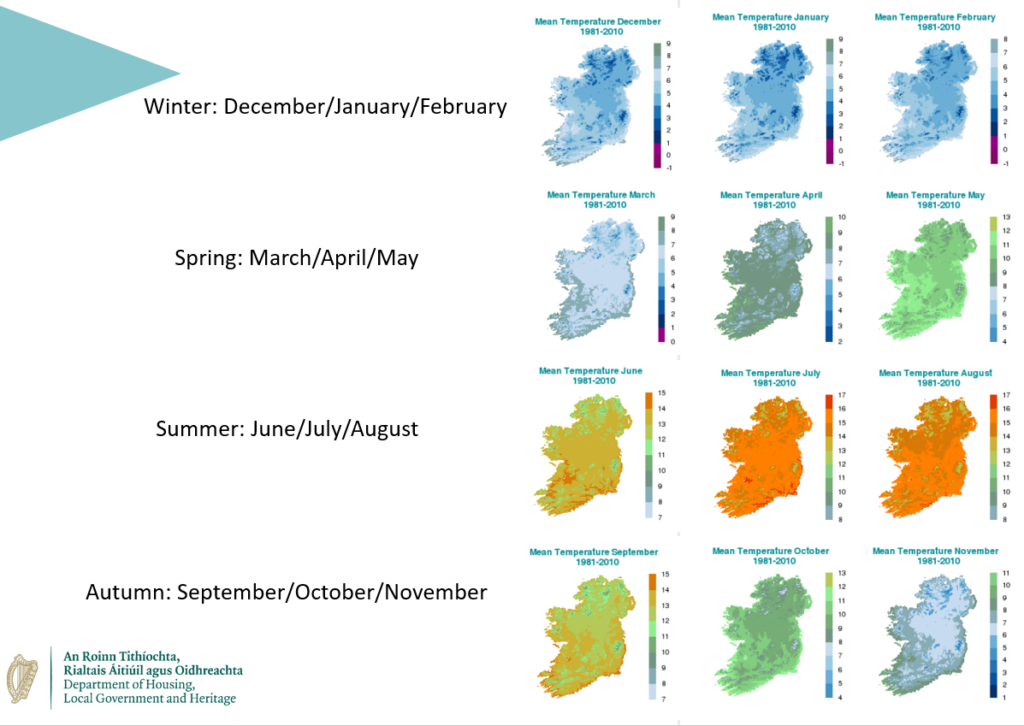In Ireland, we use the four-season system of winter, spring, summer and autumn, like many other countries in the mid-latitudes. Countries near the equator experience so very little seasonal variety, they have just two seasons, rainy or dry. Countries near the pole experience two seasons, six months of day and night. While some countries have six seasons, including a monsoon season for example. We also use ‘storm season’ in Ireland, which coincides with the start of meteorological autumn on 1st September each year.
Meteorological seasons are aligned to the monthly calendar and temperatures for the ease of monitoring and comparing weather and climate statistics globally. They are used by all national meteorological services. So regardless of what seasonal system each country uses, meteorologically and climatologically we all speak the same language worldwide by using meteorological seasons. We all know that winter is when the lowest temperatures occur, and summer the highest temperatures.
With meteorological seasons, we are all speaking the same ‘language’ globally when we talk about the weather and climate of each area.
What’s the difference between meteorological and astronomical seasons, and which is the correct term to use?
Meteorological seasons are based on the annual cycle of temperatures, while astronomical seasons are defined by the position of the Earth compared to the Sun. The traditional Irish seasons of Embolc, Bealtaine, Lughnasa and Samhain are different again. They are all correct and used in Ireland.
| Start Dates | Ireland’s Traditional | Astronomical | Meteorological |
|---|---|---|---|
| Spring Embolc |
1st/2nd Feb St Brigid’s Day |
20th March Vernal Equinox |
1st March |
| Summer Bealtaine |
1st May | 20th/21st June Summer Solstice |
1st June |
| Autumn Lughnasa |
1st August | 22nd/23rd September Autumnal Equinox |
1st September |
| Winter Samhain |
31st Oct/1st Nov | 21st/22nd December Winter Solstice |
1st December |
Table 1 Variation in the Ireland seasons (with start dates or months)
The practice of using seasons to help explain weather patterns, that is the climate, has been used since at least 1780 (see Cassidy, 1985). Meteorological seasons are far simpler and easier to remember than astronomical seasons, for example, as the start and end dates for astronomical seasons can vary each year.
What seasons would you use if you were completing seasonal averages of temperature?
In Met Éireann, meteorological seasons are used to divide the year into four parts of equal length (three full months each). This helps enormously in the calculation and provision of seasonal statistics for many climate-related products. For example, useful collaboration purposes when Met Éireann provides Irish climatological and meteorological statistics internationally, for comparison.
Is it 1st March or the Vernal Equinox or St Brigid’s Day the start of Spring?
In Ireland, it’s all of them.
While the first day of meteorological spring is 1st March each year.
Seasonal temperatures in Ireland
Seasonal contrasts between meteorological winters and summers are strong, while spring and autumn are considered the “transitional” seasons. The heat chart below illustrates the average hourly temperatures for each season over the last 30 years (1993-2022) at Dublin Airport. As shown, during meteorological spring it is normal to have cooler or colder weather when compared to meteorological summer at times during the day.
Air frosts are seasonally dependent in Ireland also. Meteorological summers are typically devoid of air frosts, while meteorological winters observe more air frosts than other meteorological seasons, peaking in January generally.
In a changing climate we expect rising temperatures, will seasons change for Ireland?
Temperatures at Dublin Airport have increased by an average of half a degree (0.5°C) each hour for meteorological summer and winter between the two 30-year period averages of 1943-1972 and 1993-2022. In the same periods, spring and autumns’ hourly temperatures have increased by an average of 0.2°C.
For the moment and even considering the different temperature increases between winter/summer and autumn/spring, there is still a strong seasonal contrast between the seasonal averages of temperatures. However, some countries are experiencing seasonal shifts as warming seasons grow longer.
Read more:
Storm Centre: www.met.ie/climate/storm-centre
Temperature Climate of Ireland: https://www.met.ie/climate/what-we-measure/temperature
National climate records: https://www.met.ie/climate/weather-extreme-records
Met Éireann’s work on climate change: https://www.met.ie/climate/climate-change
IPCC report: https://www.ipcc.ch/site/assets/uploads/2018/03/SREX-Chap3_FINAL-1.pdf
David C Cassidy (1985). Meteorology in Mannheim: The Palatine Meteorological Society, 1780-1795. https://www.jstor.org/stable/20776952
EPA. 2021. Seasonality and Climate Change: A Review of Observed Evidence in the United States. U.S. Environmental Protection Agency, EPA 430-R-21-002. https://www.epa.gov/climate-indicators/seasonality-and-climate-change
For further questions, contact enquiries@met.ie or media@met.ie
Climate Services Division, Met Éireann
Dr. Sandra Spillane, Climatologist


